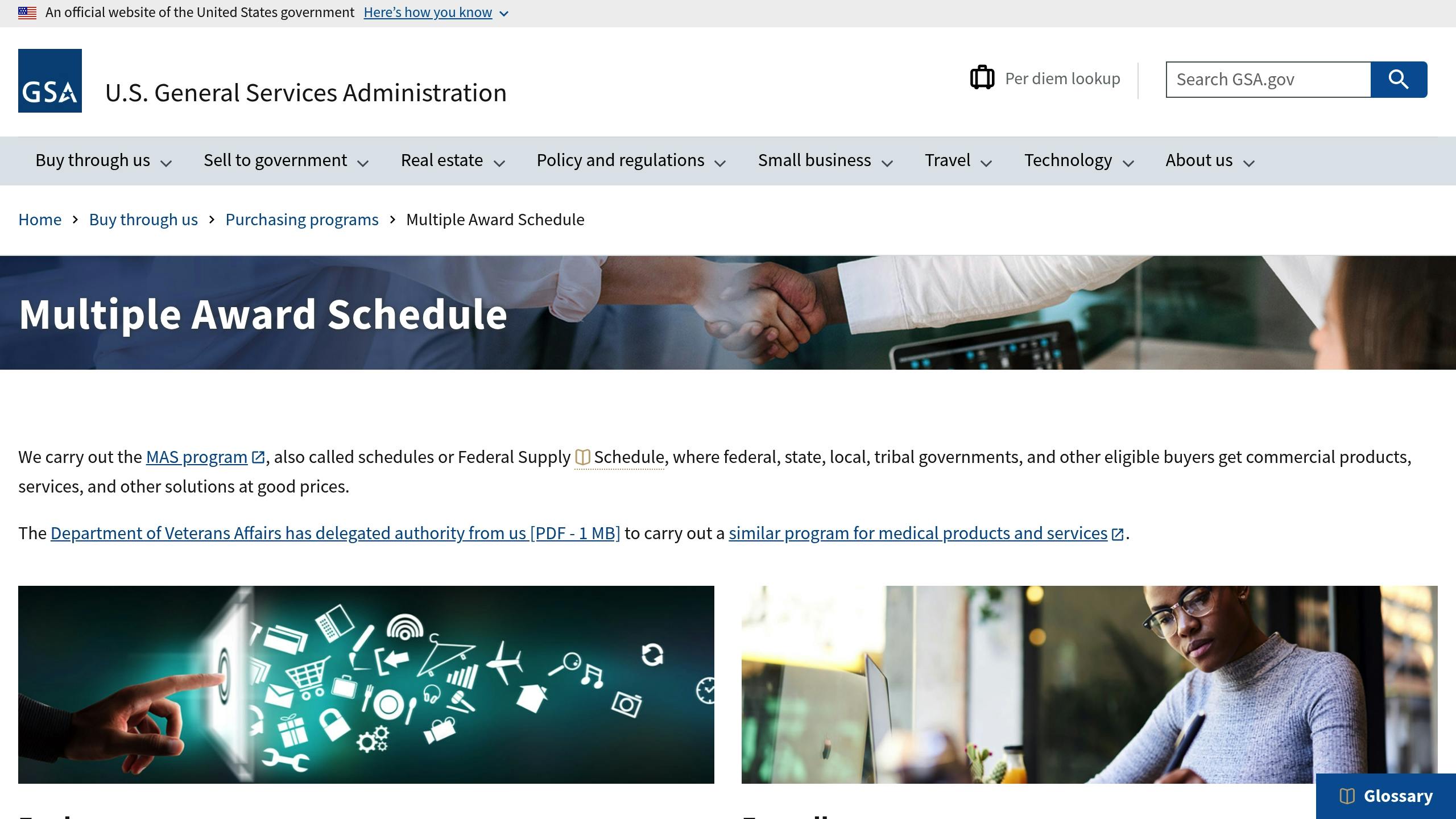When updating a GSA Schedule contract, every change falls into one of two categories: in-scope or out-of-scope. This classification affects processing time, costs, compliance, and competition requirements. Here’s what you need to know:
Key Differences
- In-Scope Modifications: Align with the original contract’s purpose and terms, such as price adjustments, product updates, or administrative changes. These are processed faster and involve minimal compliance risk.
- Out-of-Scope Modifications: Introduce new services, regions, or pricing structures not covered in the original contract. These require competitive bidding, detailed documentation, and longer review times.
Why It Matters
Misclassifying a modification can lead to legal risks, delays, or even contract termination. Proper classification ensures compliance with federal regulations and smooth contract management.
Quick Comparison
| Aspect | In-Scope | Out-of-Scope |
|---|---|---|
| Processing Time | Shorter | Longer |
| Competition | Not required | Often required |
| Compliance Risk | Low | High |
| Documentation | Standard forms | Detailed justification needed |
Understanding these distinctions helps you manage modifications effectively and avoid compliance pitfalls. Let’s dive deeper into the specifics.
Scope of Contract Training for MAS Vendors

In-Scope Modifications: Core Elements
This section dives into the essential details of in-scope modifications, expanding on the classification overview.
What Defines an In-Scope Modification
An in-scope modification stays true to the original contract’s purpose and boundaries, allowing for necessary updates. A modification qualifies as in-scope when it:
- Matches the intended service or product scope outlined in the original contract
- Falls within approved pricing and contract terms
- Maintains the core structure of the contract
- Does not significantly change how services are delivered
- Stays within the agreed-upon labor categories and skill sets
Common Types of In-Scope Changes
Here are some typical in-scope modifications and examples:
| Type of Change | Examples |
|---|---|
| Administrative Updates | Updating company name, address, or contact information |
| Price Adjustments | Annual economic price updates or temporary price reductions |
| Product Updates | Introducing new models, phasing out old ones, or applying technical updates |
| Service Adjustments | Adding features within existing service categories |
Guidelines for In-Scope Modifications
The GSA outlines specific steps to ensure modifications meet requirements:
-
Documentation Requirements
Every modification should include proper documentation, such as justification, pricing updates, technical details, and performance data. -
Compliance Standards
Modifications must align with regulations like the Federal Acquisition Regulation (FAR), GSA pricing policies, and any relevant industry standards. -
Review Process
Each modification undergoes a review to confirm pricing accuracy, technical feasibility, regulatory adherence, and its effect on contract obligations.
Next, we’ll explore modifications that extend beyond the original contract scope.
Out-of-Scope Modifications: Core Elements
What Makes a Modification Out-of-Scope
A modification is classified as out-of-scope when it:
- Introduces services or products not included in the original contract
- Requires skills or labor categories not initially outlined
- Alters how services are delivered or performed
- Expands operations beyond approved geographic areas
- Adjusts pricing in ways that go beyond allowable economic changes
Common Out-of-Scope Changes
Here’s a breakdown of typical out-of-scope modifications and their implications:
| Change Type | Description | Impact |
|---|---|---|
| Service Expansion | Adding new service categories | Requires additional technical evaluations and pricing analysis |
| Geographic Extension | Operating in areas outside the approved regions | Needs verification of past performance in the new areas |
| Structural Changes | Modifying core contract terms | Requires a full contract review and possibly recompetition |
| Pricing Restructure | Changing pricing methods | Demands updated market research and price justification |
These changes often lead to specific compliance and competition requirements.
Competition and Legal Requirements
Out-of-scope modifications come with strict legal and competitive obligations. Here’s what to keep in mind:
1. Competition Requirements
Federal regulations require that any major changes outside the original scope go through new competitive bidding processes. This ensures fairness and maintains a level playing field in the market.
2. Steps for Legal Compliance
Contractors must take the following actions when dealing with out-of-scope modifications:
- Submit a detailed explanation for the proposed changes
- Provide thorough pricing documentation
- Show technical qualifications for the new requirements
- Offer proof of past performance in related areas
3. Managing Risks
Unapproved out-of-scope changes can result in:
- Contract termination
- Disputes over payments
- Legal challenges from competitors
- Violations of federal compliance rules
To navigate these challenges, many contractors work with firms like GSA Focus for help with assessing modifications and ensuring compliance.
sbb-itb-8737801
Scope Assessment Guidelines
Understanding the boundaries of in-scope and out-of-scope modifications is critical, and a thorough scope assessment helps ensure clarity.
Contract Terms Review
Carefully examine the original contract terms to identify any potential conflicts or adjustments:
- Scope descriptions and labor categories
- Geographic coverage and performance requirements
- Price structure and adjustment provisions
| Assessment Area | Key Questions | Risk Level |
|---|---|---|
| Service Scope | Does the change introduce new service categories? | High |
| Geographic Coverage | Are new locations outside approved areas? | Medium |
| Price Structure | Do changes exceed allowed economic adjustments? | High |
| Performance Requirements | Are new skills or certifications needed? | Medium |
For example, expanding services to a new region may require a detailed review to ensure compliance with the original agreement.
Change Impact Analysis
Evaluate how changes might affect technical, financial, and operational aspects:
- Technical Impact: Identify adjustments to service delivery, including new equipment, certifications, or expertise needed.
- Financial Impact:
- Check if price changes go beyond standard economic adjustments.
- Consider any new investments or shifts in profit margins.
- Operational Impact: Look at how daily operations, staffing, and quality control might be affected.
These evaluations help pinpoint areas that may need extra attention or adjustments.
Getting Expert Input
Bring in experts to ensure modifications comply with GSA contract requirements, especially in situations like:
- Modifications involving multiple service categories
- Adjustments to pricing structures
- Plans for geographic expansion
- Introduction of new technical requirements
Experts can review documentation, ensure compliance with federal standards, and assist in negotiations with contracting officers. This step minimizes risks, avoids disputes, and keeps your business aligned with contract terms, so you can maintain focus on core operations.
Modification Management Steps
Managing modifications effectively requires thorough documentation and a structured approach.
Documentation Requirements
Accurate and detailed records are the backbone of successful modification management. Key documents include:
| Document Type | Purpose | Required Elements |
|---|---|---|
| Modification Request | Formal proposal for changes | Scope details, pricing impact, timeline |
| Technical Analysis | Assessment of service delivery | Skills requirements, equipment needs |
| Price Analysis | Evaluation of financial impact | Cost breakdowns, market comparisons |
| Performance Records | Historical contract information | Past modifications, compliance history |
Each document should clarify whether the changes fall within the contract’s scope and include records of all related communications to ensure compliance.
Once documentation is in place, maintaining clear lines of communication with contracting officers becomes critical.
Agency Communication Steps
Start with a preliminary discussion to outline your proposed changes. When presenting your case, make sure to include:
- A clear justification for the modification
- A detailed analysis of its operational impact
- Supporting documents that confirm compliance
- Proposed timelines for implementation
Keep a record of all interactions to create a reliable audit trail. If challenges arise, consulting with experts can simplify the process.
Professional Support Options
For complex modifications, external expertise can help navigate compliance requirements and reduce operational risks. A consulting firm like GSA Focus (https://gsascheduleservices.com) specializes in managing contract modifications and offers tailored support.
"GSA Focus is the full-service GSA Contract solution for small businesses. Our comprehensive, full-service approach is paired with an affordable price to offer the very best option to get your GSA Schedule."
- GSA Focus
GSA Focus boasts a 98% success rate, processes modifications 4-6× faster, and handles 95% of the paperwork.
Professional assistance can be especially useful for tasks like:
- Modifications involving multiple service categories
- Adjustments to complex pricing structures
- Requests for geographic expansion
- Updates to technical requirements
Partnering with experts ensures compliance, reduces administrative workload, and allows you to focus on your core business priorities.
Managing Modifications Effectively
Let’s simplify how to handle modifications efficiently while staying organized and compliant.
Key Differences
Here’s a quick comparison of in-scope vs. out-of-scope modifications:
| Aspect | In-Scope Modifications | Out-of-Scope Modifications |
|---|---|---|
| Contract Terms | Match the original scope | Go beyond the original agreement |
| Review Process | Easier and quicker to review | Requires a fresh competitive process |
| Documentation | Use standard forms | Needs detailed justification |
| Timeline | Shorter processing time | Longer review period |
| Risk Level | Lower risk of compliance issues | Faces higher scrutiny |
Steps to Stay Organized
To manage modifications effectively, you need a clear plan and strong communication:
-
Regular Contract Reviews
Schedule quarterly reviews to identify potential modifications early. -
Centralized Documentation
Keep all modification records in one place to ensure compliance and streamline decision-making. -
Consult Experts When Needed
For complex changes, bring in specialists to guide the process and reduce risks. -
Establish a Communication Plan
Work closely with your contracting officer. Include monthly updates, quarterly reviews, and immediate alerts for any changes.
Related Blog Posts
- How to Remove Products from GSA Schedule
- Common GSA Compliance Mistakes And Fixes
- GSA Contract Modifications: Key Terms Explained
- Checklist for Substantive GSA Contract Modifications


